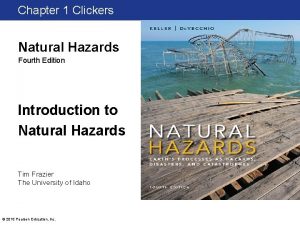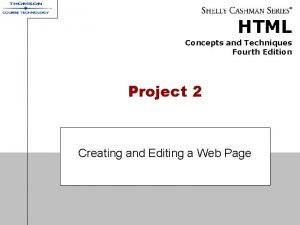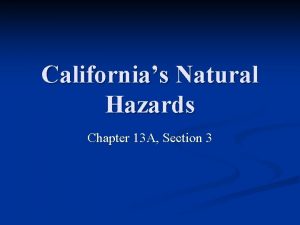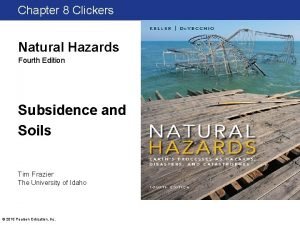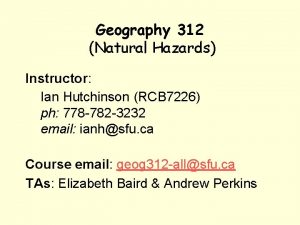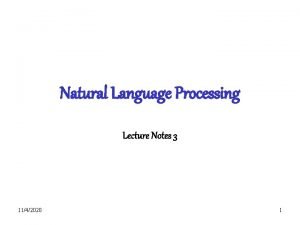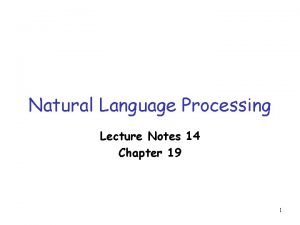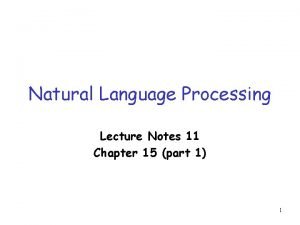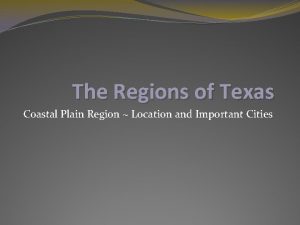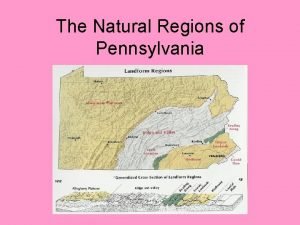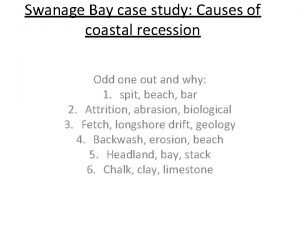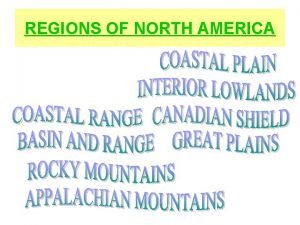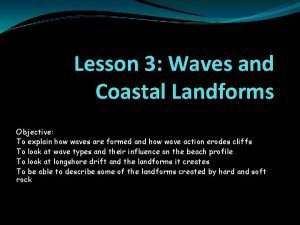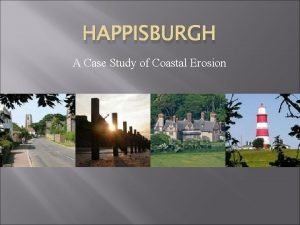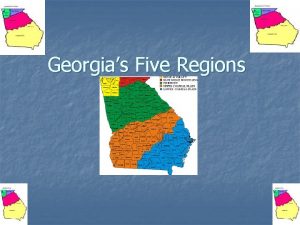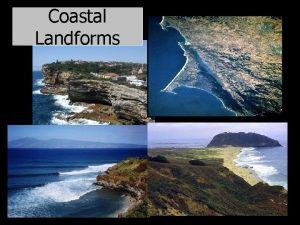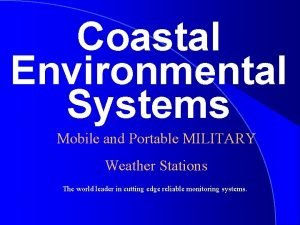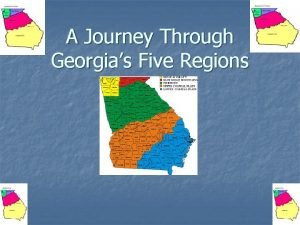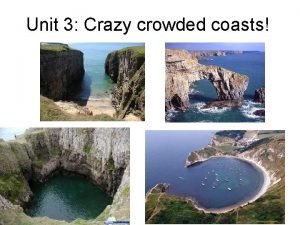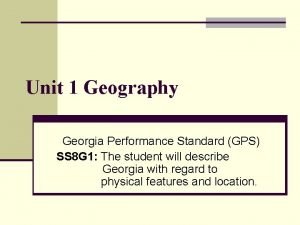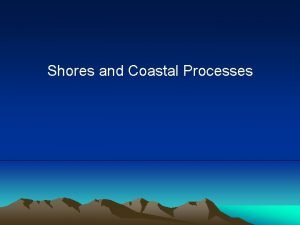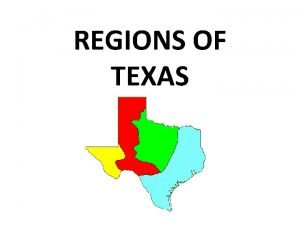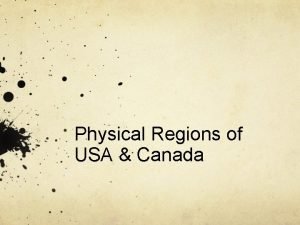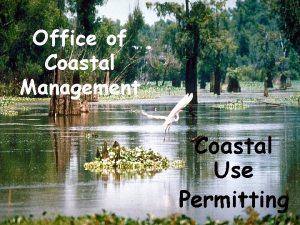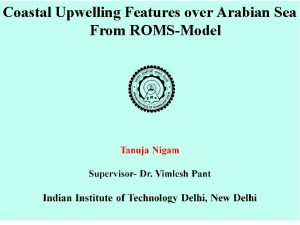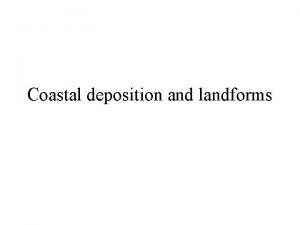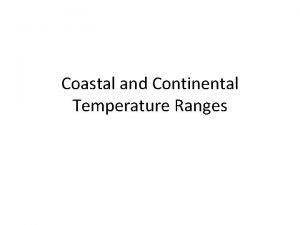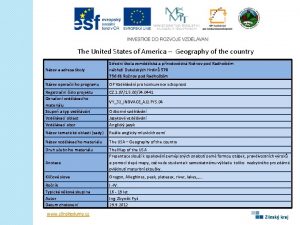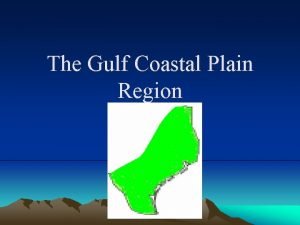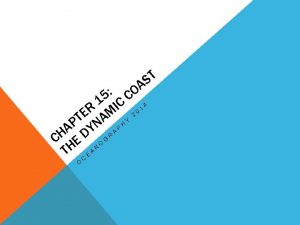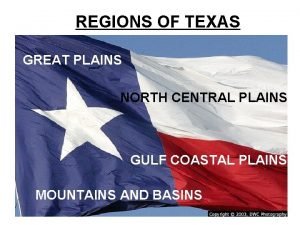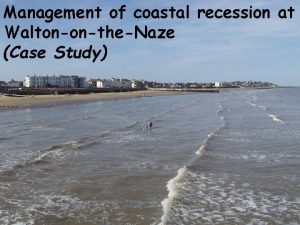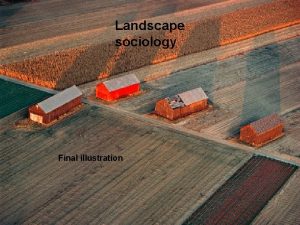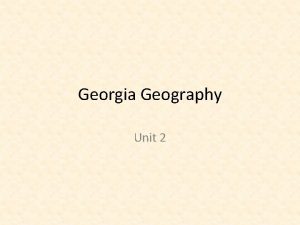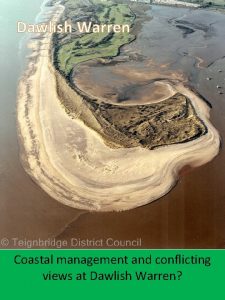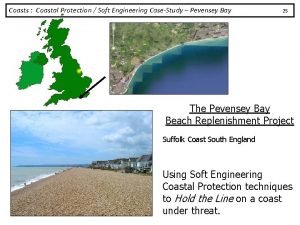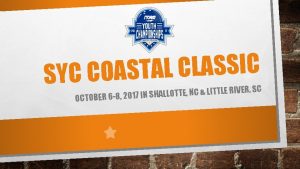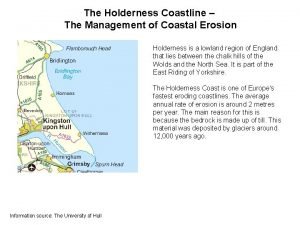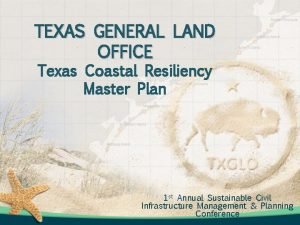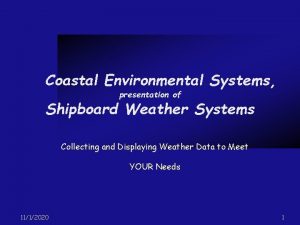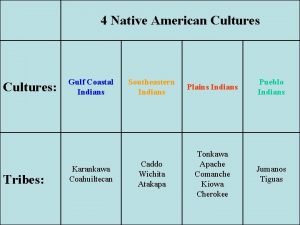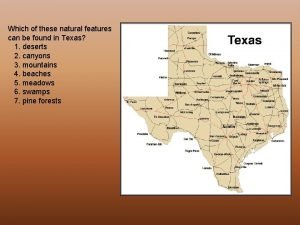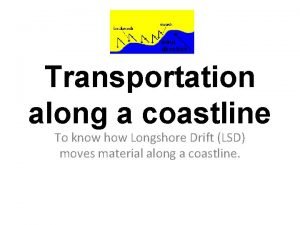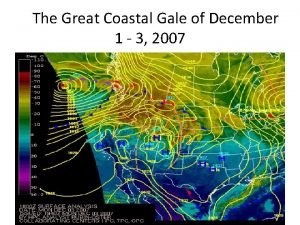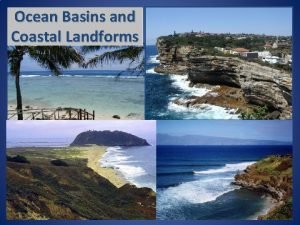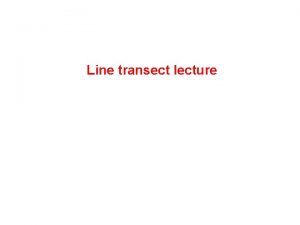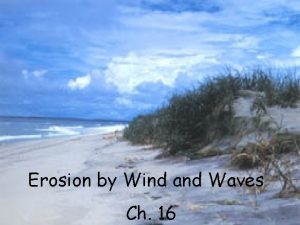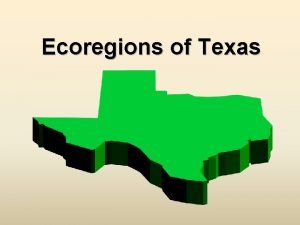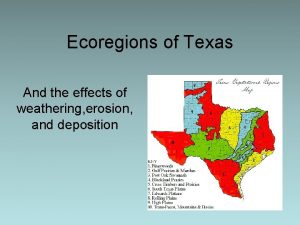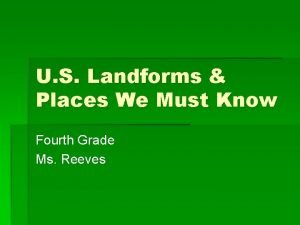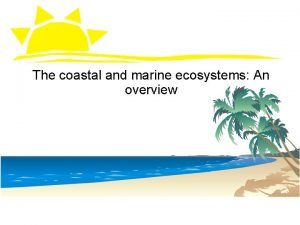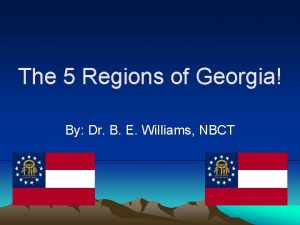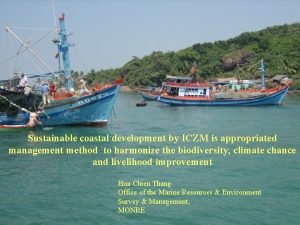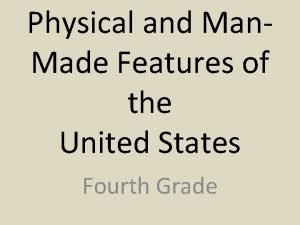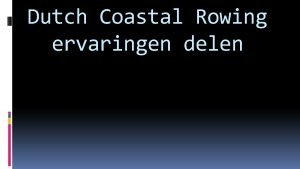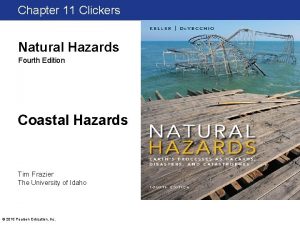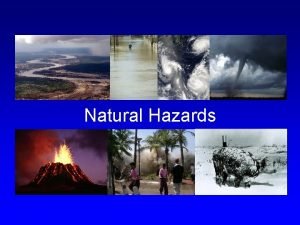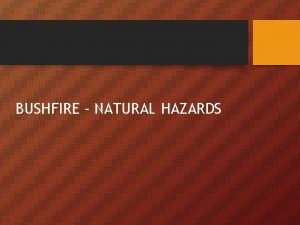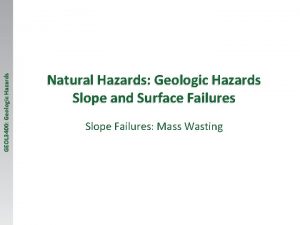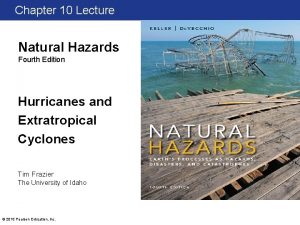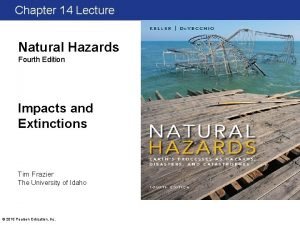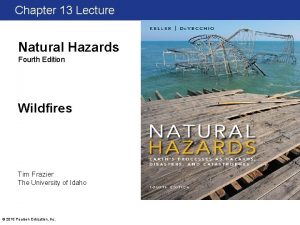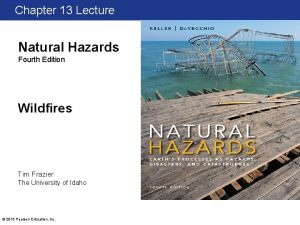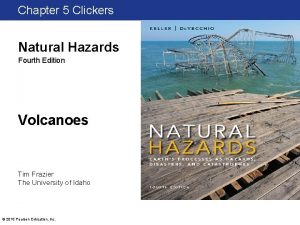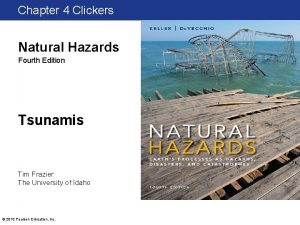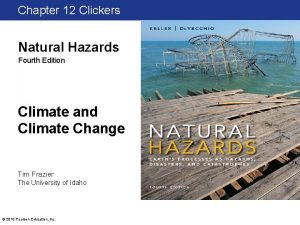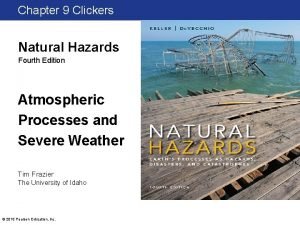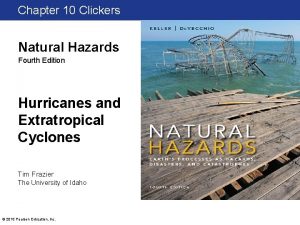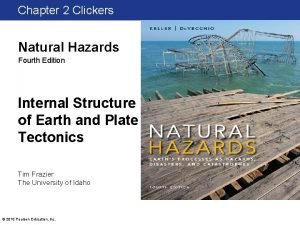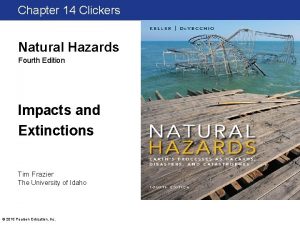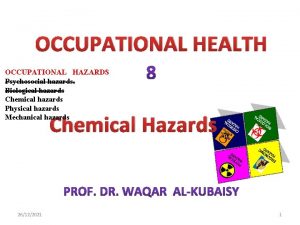Chapter 11 Lecture Natural Hazards Fourth Edition Coastal



























































































- Slides: 91

Chapter 11 Lecture Natural Hazards Fourth Edition Coastal Hazards Tim Frazier The University of Idaho © 2015 Pearson Education, Inc.

Learning Objectives • Discuss the role of plate tectonics influencing coastal zone morphology and process. • Explain coastal processes, such as waves, beach forms and processes, and rising sea level. • Summarize the effects of sea level rise on coastal processes. • Explain why coastal erosion rates vary along different U. S. coastlines. © 2015 Pearson Education, Inc.

Learning Objectives, cont. • Synthesize the coastal erosion hazards. • Summarize the potential link between coastal processes and other natural hazards. • Evaluate how use of the coastal zone affects coastal processes. • Summarize what we can do to minimize coastal hazards. • List options available for coastal management. © 2015 Pearson Education, Inc.

Folly Island • Barrier island south of Charleston, South Carolina – Barrier to ocean waves that would strike the mainland – About 10 km (~6 mi) long, less than 1 km (~0. 6 mi) wide – Most of island has an elevation of 1. 5 -3 m (~5 -10 ft) above sea level • Typical Atlantic barrier island – Eroding at a high rate • East-facing shoreline has been retreating for at least 160 years • Pair of rocky barriers (jetties) aiding in the erosion – Built to prevent the entrance of Charleston Harbor from being blocked by sand • Facing tough decisions on how to adapt to and manage future coastal erosion © 2015 Pearson Education, Inc.

Eroding Barrier Islands along the South Carolina Coast © 2015 Pearson Education, Inc.

11. 1 Introduction to Coastal Hazards • Continental and oceanic processes converge to produce landscapes that are capable of rapid change • Coasts are greatly influenced by plate tectonics – East Coast United States and Canada, Canadian Arctic is passive • Because they are not close to convergent boundary • Have wide continental shelves with barrier islands and sandy beaches – West Coast United States and Canada is active • It is close to convergent and transform boundaries • Have sea cliffs and rocky shorelines © 2015 Pearson Education, Inc.

11. 1 Introduction to Coastal Hazards, cont. • Coast also influenced by climate and organisms – Alaska, Canada, and Great Lakes affected by seasonal ice or glaciers – Temperate region coastlines affected by marsh vegetation – Tropical and subtropical coasts affected by mangroves and coral reefs • Most serious coastal hazards include – – Strong coastal currents Coastal erosion Storm surge (Chapter 10) Tsunamis (Chapter 4) © 2015 Pearson Education, Inc.

11. 2 Coastal Processes: Waves • Waves are caused by offshore winds producing friction over water • Size of waves depend on – Speed of wind – Duration of wind – Fetch – distance wind blows over water surface • Waves become sorted into groups as they move away from their origin – Rogue waves are exceptions to these groups © 2015 Pearson Education, Inc.

Waves, cont. • Rogue waves – Appear to form by constructive interference • Multiple, similarly sized waves intersect to create a much larger wave • Wave may be as high as the sum of the intersecting waves – Can be extremely dangerous to the unsuspecting beachgoer • Can appear out of nowhere • Lives are lost – sweep individual into ocean – Can also appear out of nowhere in the open ocean • Can threaten ships • Waves can reach 30 m (~100 ft) – ships are designed to withstand 15 m (~50 ft) waves © 2015 Pearson Education, Inc.

Rogue Wave © 2015 Pearson Education, Inc.

Waves, cont. • Wave form – Wave height • Distance from crest to trough – Wavelength • Distance from crest to crest – Wave period • Time between crests © 2015 Pearson Education, Inc.

Waves, cont. • To understand wave energy transmission, useful to study the wave motion – Motion is circular in open ocean – Circles decrease in diameter with increasing depth • Waves in shallow water become ellipses as waves “feel bottom” – When depth is ½ wavelength – May eventually become a narrow ellipse with a back-andforth movement © 2015 Pearson Education, Inc.

Waves and Beaches © 2015 Pearson Education, Inc.

Waves, cont. • Wave sets generated by storms are called swells – Swells enter shallow water, become unstable and break – Mathematical equations can be used to predict wave height, period and velocity • Waves move in open ocean with little energy loss – Energy is spent on reaching coastline – Wave energy is proportional to square of wave height • On coast, wavelength and velocity decrease, wave height increases, wave period is constant © 2015 Pearson Education, Inc.

Waves, cont. • Variations along a coastline – Irregularities in topography cause variations in wave height as it approaches shore – A single wave is called a wave front • • • Irregular coastlines have headlands The shape of the coast is similar underwater to that of the coastline Water gets progressively shallower close to shore As the wave approaches the shore, it slows at the headland first This causes the wave front to bend around the headland (refraction) © 2015 Pearson Education, Inc.

Waves, cont. • Effects of wave refraction – Wave normals, perpendicular to wave fronts pointing toward shoreline – Wave refraction causes normal to converge and diverge – Convergence • Wave heights and energy increases • Waves are bigger here – Divergence • Wave heights and energy decreases © 2015 Pearson Education, Inc.

Convergence and Divergence of Wave Energy © 2015 Pearson Education, Inc.

Waves, cont. • Breaking waves – Plunging breakers • Waves that pick up quickly • Typical on steep beaches • More erosive – Spilling breakers • Waves that spill gently • Typical on wide, flat beaches • More likely to deposit sand © 2015 Pearson Education, Inc.

Types of Breakers © 2015 Pearson Education, Inc.

Beach Form and Processes • Beach consists of loose material which has accumulated by wave action on shoreline • Type of beach material depends on source of sand – White beaches from shell and coral – Black beaches from volcanic rock – Brown beaches from quartz and feldspar © 2015 Pearson Education, Inc.

Beach Form and Processes, cont. • The beach onshore – Landward extent of a beach on seashore or lakeshore • Line of sand dunes • Line of permanent vegetation or • Sea cliff or bluff forms from erosion of rock or sediment – Beaches are divided into • Berm – Beach portion that slopes landward – Formed by deposition of sediment by waves • Beach face – Beach portion that slopes toward water – In the swash zone where waves swash and backwash © 2015 Pearson Education, Inc.

Beach Terms © 2015 Pearson Education, Inc.

Beach Form and Processes, cont. • The beach offshore – Swash zone • Zone where waves swash and backwash on the beach – Surf zone • Where turbulent waves move after waves break – Breaker zone • Where the waves become unstable, peak, and break • Longshore bar forms beneath breakers • Longshore trough forms landward from bar © 2015 Pearson Education, Inc.

Beach Form and Processes, cont. • Sand transport – Littoral transport • Sand movement parallel to shore • Beach drift – Sand moving in zigzag pattern in swash zone • Longshore drift – Transport of sand by longshore currents – Longshore currents • Current that flows parallel to shoreline as a result of up and back movement of water in swash zone – Updrift and downdrift • Indicate the direction in which sediment is moving or accumulating along the shore © 2015 Pearson Education, Inc.

Transport of Sediment along a Coast © 2015 Pearson Education, Inc.

11. 3 Sea Level Change • The level of the sea is constantly changing • Relative sea level – Position of the sea at the shore – Influenced by movement of both the land water • Eustatic sea level – Global sea level – Controlled by processes that affect overall volume of water in the ocean and shape of the basins © 2015 Pearson Education, Inc.

11. 3 Sea Level Change, cont. • Eustatic sea level (global sea level) – Rises or falls when the amount of water in the world’s oceans increases or decreases – Climate/average air temperature • Temperature increases cause volume of water to expand • Temperature decreases cause contraction of water • Changes in temperature cause ice on land to melt or snowfall to increase – Volume of water in ice sheets, glaciers increases, ocean water linked – Tectonic processes • Changes ocean basin shape over long period of time © 2015 Pearson Education, Inc.

11. 3 Sea Level Change, cont. • Relative sea level – Glacier melt or earthquakes can cause uplifting of land • Decrease in sea level – Rates of deposition, erosion, or subsidence makes the level rise or fall – Tides caused by gravitational pull of the moon cause daily and seasonal changes – Weather conditions • Changes in wind speed – High winds pile up water and increase water height in open water – Swell increases both water level and wave heights when it reaches the shore • Changes in atmospheric pressure – Can add a meter or more to height of storm surge © 2015 Pearson Education, Inc.

11. 4 Geographic Regions at Risk from Coastal Hazards • Coastal hazards are present on both seacoasts and lakeshores – Atlantic, Pacific, Gulf, and Arctic coasts in North America – Large lakes such as the Great Lakes, Great Bear Lake, Lake Winnipeg have coastal conditions similar to the ocean • Coastal erosion is a more universal hazard – All 30 U. S. states bordering the ocean – Canadian provinces bordering the ocean – Those also bordering the Great Lakes © 2015 Pearson Education, Inc.

11. 4 Geographic Regions at Risk from Coastal Hazards, cont. • Strong nearshore currents are also common problems on coastlines that have regular, strong surf conditions – – California and Hawai’i Any coast with breaking waves Rip currents on U. S. Gulf and East Coast beaches Astronomical tides in narrow bays and channels • Coastlines that are subsiding are at particular risk – Coastlines that are close to sea level • Gulf and East coasts • Arctic Canada and North Slope of Alaska • Atolls in the Pacific © 2015 Pearson Education, Inc.

Rising Sea Level Has the Greatest Effect on Low Coastlines © 2015 Pearson Education, Inc.

11. 5 Effects of Coastal Processes • Create hazard for both individuals and communities – Individuals • Safety hazards during swimming • Safety and property hazards during storm surges and tsunamis – Communities • Long-term hazards related to erosion and sea level rise • Barrier islands and spits – Shoreline is constantly shifted – Can move an entire island, the inlets between islands, or the separation of a spit from the mainland • Poor places for coastal development © 2015 Pearson Education, Inc.

Barrier Islands Continually Change Shape and Location © 2015 Pearson Education, Inc.

Rip Currents • Powerful currents that move large amounts of water away from shore – Develop when waves pile up water between longshore bar and swash zone – Becomes concentrated in narrow zones • Serious coastal hazard – In United States, kill more than hurricanes and earthquakes annually – Currents are narrow; widen and dissipate once they reach line of breaking waves – Escape requires swimming parallel to shore; don’t panic – Recognized as a relatively quiet area in the surf zone © 2015 Pearson Education, Inc.

Rip Currents and Flow in a Rip Current © 2015 Pearson Education, Inc.

Coastal Erosion • Becoming recognized as a serious worldwide problem – Continuing global sea rise – Extensive development in the coastal zone • A more continuous, predictable process than other natural hazards • Large amounts of money spent but solutions are temporary © 2015 Pearson Education, Inc.

Coastal Erosion, cont. • Beach erosion – Beach Budget – easy way to visualize erosion • Input – Longshore and beach drift bringing sediment from upshore – Local erosion of dunes and cliffs • Output – Longshore and beach drift bringing sediment away from shore – Storm waves – On-shore winds • Storage – Sediment on the beach – Beach grows when input exceeds output – Beach erodes when output exceeds input © 2015 Pearson Education, Inc.

Example of a Beach Budget © 2015 Pearson Education, Inc.

Coastal Erosion, cont. • Cliff erosion – Sea cliffs and lakeshore bluffs erode due to wave action, running water, and landslides – Causes the cliffs and bluffs to retreat – Human activities increase erosion rate • Increase surface runoff • Increase groundwater discharge • Addition of weight to cliff – Can be monitored using LIDAR © 2015 Pearson Education, Inc.

Sea Cliff and Beach © 2015 Pearson Education, Inc.

Sea Cliff Erosion © 2015 Pearson Education, Inc.

11. 6 Linkages between Coastal Processes and Other Natural Hazards • Earthquakes, volcanic eruptions, tsunamis – Change the shape of shoreline • Storm waves, storm surge, and coastal flooding – Increase coastal erosion • Landslides – Caused by eroding cliffs and bluffs • Climate change – Storm frequency and intensity change with climate conditions © 2015 Pearson Education, Inc.

Storms Contribute to Coastal Erosion © 2015 Pearson Education, Inc.

Hazardous Room with a View © 2015 Pearson Education, Inc.

11. 6 Linkages with Other Natural Hazards, cont. • 2010 Oil Spill – Emphasizes the fact that coastal processes are linked to environmental problems – Predicting the movement of the oil along the beaches and in salt marshes requires detailed coastal information on • • • Wave height and frequency Direction and rate of longshore transport Strength of tidal flow into and out of barriers and island inlets How far inland tidal flow inundates salt marshes How salt marsh vegetation and sediment interact with the oil The effects of the oil on life on beaches and salt marshes © 2015 Pearson Education, Inc.

Gulf of Mexico 2010 Oil Spill © 2015 Pearson Education, Inc.

11. 7 Natural Service Functions of Coastal Processes • Pleasing landscapes – Cliffs and bluffs are result of wave action and erosion • Beaches – Maintained or created by erosion and deposition – Provide a number of their own service functions • Renewal of ecosystems • Recreation – Swimming, sailing, fishing, and sunbathing © 2015 Pearson Education, Inc.

Sea Arch Eroded from Rocky Headland © 2015 Pearson Education, Inc.

11. 8 Human Interaction with Coastal Processes • Human interference has caused considerable erosion – Most problems in highly populated and developed areas • Atlantic, Gulf, and Pacific coasts • Great Lakes • Some parts of Canada • Efforts to stop coastal erosion involve engineering structures that impede littoral transport – Interrupt movement of sand – Cause beaches to grow in some areas and erode in others – Damage beachfront property © 2015 Pearson Education, Inc.

The Atlantic Coast • Characterized by barrier islands – Long narrow islands of sand separated from the mainland by a lagoon or bay – Many have been altered by human use • Removal of coastal dunes – Increased vulnerability to storms • Jetty construction – Interrupts longshore drift – Increases erosion at some locations © 2015 Pearson Education, Inc.

The Outer Banks of North Carolina © 2015 Pearson Education, Inc.

Urban Development with Jetty Increases Beach Erosion © 2015 Pearson Education, Inc.

The Gulf Coast • Has numerous barrier islands like the Atlantic Coast • One study suggested human modification has accelerated coastal erosion by 30 to 40 percent in the past 100 years compared to prehistoric rates • Erosion due to – Coastal engineering structures – Subsidence due to groundwater and petroleum withdrawal – Damming of rivers © 2015 Pearson Education, Inc.

The Pacific Coast • Human modification not had as long a history of development as Atlantic Coast • Trend to armor the coast is evident – Building of seawalls – Trend for more and accelerated coastal defenses has stalled in the past few decades • Debating the future of beach development and what action to take – Result of rising sea levels and increased human use © 2015 Pearson Education, Inc.

The Great Lakes • Periodic problem for all the Great Lakes – Particularly troublesome on Lake Michigan shoreline – Energy exerted by waves depends on lake levels – Erosion of lakeshore bluffs a problem • Severity of erosion depends on: – – Existence of coastal dunes Orientation of the coastline Groundwater seepage Existence of protective structures © 2015 Pearson Education, Inc.

Lakes Have Coastal Erosion Problems © 2015 Pearson Education, Inc.

Canadian Seacoasts • Canada has longest ocean shoreline in the world – Faces a serious erosion problem • Sandy coastlines erode more quickly than rocky shores • Entire islands off of Nova Scotia have disappeared • Government spends about $1 billion on projects related to the coastline © 2015 Pearson Education, Inc.

11. 9 Minimizing the Effects of Coastal Hazards • Can appear that coastal hazards are easier to control than other hazards – Interactions among coastal processes are actually complex – Efforts to combat erosion and sea level rise often met with failure or unintended consequences • Most efforts focus on stabilizing a beach at its present location – Hard stabilization: creating structures meant to protect shoreline – Soft stabilization: adding sand to depleted beaches © 2015 Pearson Education, Inc.

Hard Stabilization • Engineering structures to improve navigation or retard erosion – Seawalls – Groins – Breakwaters and jetties • Problem is that they interfere with littoral transport and often cause undesirable deposition and erosion © 2015 Pearson Education, Inc.

Hard Stabilization, cont. • Seawalls – Structures built parallel to shoreline – Help retard erosion and protect buildings from damage – Construction problems • At base of a sea cliff or lakeside bluff may not be effective because the cliff is eroded • Vertical design reflects storm waves and redirects energy to shore promoting beach erosion • Generally cause environmental and aesthetic degradation • Must be carefully tailored to specific sties – Can cause more problems than they solve • Should ideally not be used where beach preservation is a goal © 2015 Pearson Education, Inc.

Seawalls Increase Beach Erosion © 2015 Pearson Education, Inc.

Hard Stabilization, cont. • Groins – Linear structures built perpendicular to shoreline usually in groups – Each groin traps sand from longshore drift • Small amount of sand accumulates updrift, building an irregular but wider beach • However, causes increased erosion in downdrift area – Erosion may be minimized through beach nourishment • Take sand off ocean floor and placing onto beach • Artificially fills each groin • Reduces sand drawn from longshore drift – Despite efforts to prevent it, groins still often cause undesirable erosion © 2015 Pearson Education, Inc.

Beach Groins © 2015 Pearson Education, Inc.

Hard Stabilization, cont. • Breakwaters and jetties – Linear structures of riprap or concrete that protect limited stretches of shoreline from waves – Breakwaters • Built parallel to shore • Intercepts waves to protect boats or ships in harbor • Blocks littoral transport, increasing erosion and deposition in different locations – Jetties • Built in pairs perpendicular to shoreline near river or inlet • Designed to keep channel open • Causes increased erosion and deposition in other locations – Impossible to build without interfering with longshore movement of beach sediment © 2015 Pearson Education, Inc.

Engineering Structures Built in the Surf Zone Cause Change © 2015 Pearson Education, Inc.

Soft Stabilization • Beach Nourishment – Adding sand to replace sand that has eroded • Hope is to create a positive beach budget • Provides recreational beach and protection from shoreline erosion – Aesthetically preferable to hard stabilizations – Expensive and must be repeated at regular intervals – Sand must be chosen carefully to match conditions at beach • Coastal Zone Bioengineering (CZB) – Uses living or dead plants to assist in erosion control – Examples • Stabilizing dunes with native dune grassland or other vegetation • Palm trees with dense, strong root system retards erosion © 2015 Pearson Education, Inc.

Beach Nourishment © 2015 Pearson Education, Inc.

Miami Beach Shape after Nourishment © 2015 Pearson Education, Inc.

11. 10 Perception of and Adjustment to Coastal Hazards: Perception of Coastal Hazards • Perception of erosion hazard depends on people’s experience, proximity to the coastline, and probability of suffering property damage • Many people are complacent about wave and current hazards – Experiences are with are safe swimming and wading conditions – Unaware of rip currents and instead think they are safe areas © 2015 Pearson Education, Inc.

Adjustment and Management of Coastal Hazards • Adjustments – Strong currents • Education and awareness is best adjustment • Restricting swimming, posting warnings, beach forecasts – Coastal erosion • Beach nourishment – “soft solution” – Imitates natural processes • Land use changes – “Managed Retreat Solution” – Avoid building in hazardous areas and relocate threatened buildings • Shoreline stabilization – “hard solution” – Groins and seawalls – Coastal point of interest protected by engineering © 2015 Pearson Education, Inc.

Adjustment and Management of Coastal Hazards, cont. • Management – Adaptive management • Use of science, statistical analysis, and modeling with goal of reducing uncertainty • Promotes sustainable casts and beaches • Communicates alternatives for discussion and negotiation • Recognizes that future change is inevitable and that management can change as conditions change – Integrated coastal zone management • Maintain the ecological function and integrity of the coastal zone • Encourage sustainable solutions to coastal one management • Reduce or minimize potential and present conflicts resulting from development in the coastal zone, use of coastal resources, and recreational use of the coastal zone © 2015 Pearson Education, Inc.

Adjustment and Management of Coastal Hazards, cont. • Tasks in managing coastal erosion – Determine rate of erosion • Based on historic shoreline change or statistical analysis of oceanographic environment • Maps made showing erosion – Determine setback • Minimum standards for coastal erosion management programs • Distance from shoreline where development will be allowed – Use information to manage coastal zone • At a crossroads today • Two paths – Ever-increasing coastal defenses in attempt to control erosion – Learning to live with coastal erosion through flexible environmental planning and wise land use in the coastal zone © 2015 Pearson Education, Inc.

Adjustment and Management of Coastal Hazards, cont. • Five principles of living with coastal erosion 1. Coastal erosion is a natural process rather than a natural hazard 2. Any shoreline construction causes change 3. Stabilization of the coastal zone through engineering structures protects property, not the beach itself 4. Engineering structures designed to protect a beach may eventually destroy it 5. Once constructed, shoreline engineering structures produce a costly trend in coastal development that is difficult, if not impossible, to reverse © 2015 Pearson Education, Inc.

Adjustment and Management of Coastal Hazards, cont. • If you consider purchasing land in the coastal zone 1. Allow for a good setback from the beach, sea cliff, or lakeshore bluff 2. Be high enough above the water level to avoid flooding and take into account rising sea level 3. Construct buildings to withstand adverse weather, especially high winds 4. If hurricanes are a possibility, be sure there adequate evacuation routes © 2015 Pearson Education, Inc.

Folly Island – Applying the 5 Fundamental Concepts • Barrier island receding at a rate of 2 m (~7 ft) per year – Result of both natural and human caused changes to the environment – Started with construction of Charleston jetties • Impede the south-flowing longshore drift, which had replinished Folly • Upset the natural balance between sand supply and beach erosion • This imbalance due to human attempts to minimize nature’s will combined with sea level rise to create the erosion problems © 2015 Pearson Education, Inc.

Groins on Folly Island © 2015 Pearson Education, Inc.

Folly Island – Applying the 5 Fundamental Concepts, cont. • Construction of groins and seawalls – Groins resulted in updrift beach deposition but accelerated erosion downdrift – Seawalls provided temporary protection of their homes • Over the long term, lead to excess erosion and damage elsewhere – Beach nourishment after homeowners sued over construction of jetties • Repeated every eight years • Sand placed on the beach is being carried out onto the continental shelf and completely removed from beach system – Overruling of regulations allow some residents to build mitigation structures to protect their homes © 2015 Pearson Education, Inc.

Attempts to Mitigate Coastal Flooding and Erosion on Folly Island Nourishment of Folly Beach © 2015 Pearson Education, Inc.

Folly Island – Applying the 5 Fundamental Concepts, cont. • South Carolina’s Beachfront Management Act – Implemented in 1990 – Establishes setback distances for new construction on shoreline – However, Folly Island is temporarily exempt • Instead, new houses on Folly Island are elevated based on FEMA insurance rates maps • Not based on sea level rise during the lifetime of the structure • Challenge is to adopt coastal management policies and regulations that are forward looking, consider coastal erosion, local subsidence, and sea level rise © 2015 Pearson Education, Inc.

New Home Construction on Folly Island © 2015 Pearson Education, Inc.

Chapter 11 Summary • The coastal environment is incredibly dynamic and capable of rapid change. • Coastal morphology around the globe is greatly influenced by plate tectonics, and there are major differences between a coast on the leading edge of a continent and near a plate boundary (such as the U. S. West Coast) and a more passive coastline far from a major plate boundary (such as the U. S. East Coast). © 2015 Pearson Education, Inc.

Chapter 11 Summary, cont. • Impacts of coastal hazards are increasing for a variety of reasons, including the fact that about 50 percent of the population of the United States today lives in large cities in the coastal zone, or at least in coastal counties. • The most serious coastal hazards include strong coastal currents, coastal erosion of beaches and sea cliffs, storm surge from hurricanes and cyclones, and tsunamis. © 2015 Pearson Education, Inc.

Chapter 11 Summary, cont. • Waves that arrive at coastlines are generated by offshore winds, and the size of the waves is related to the velocity or speed of the waves, the duration that the wind blows in the storm area, and the distance that the wind blows across the water surface (fetch). • Waves develop in a variety of sizes and shapes. • As waves enter shallow coastal water, remarkable transformations take place. © 2015 Pearson Education, Inc.

Chapter 11 Summary, cont. • Waves seldom arrive at the coasts with their wave fronts perfectly parallel to the coast. • The two main types of breakers are spilling and plunging breakers. • Basic terms used to describe a beach are berms, beach face, longshore trough, longshore bar, swash zone, surf zone, and breaker zone. © 2015 Pearson Education, Inc.

Chapter 11 Summary, cont. • Sea level is always changing, and it can change over time scales of hours and days to many thousands of years. • Relative sea level refers to sea level influenced by tectonic movements of the land, as well as movements of the water and climatic factors. • Eustatic sea-level curves refer to worldwide changes that are linked to climatic factors and global change affecting the overall volume of water in the ocean. © 2015 Pearson Education, Inc.

Chapter 11 Summary, cont. • Coastal erosion is essentially a worldwide hazard. • Rates of coastal erosion related to beaches and sea cliffs are highly variable. • Individual hazards for people swimming in the ocean are related to strong currents. • Coastal erosion is a serious natural hazard. © 2015 Pearson Education, Inc.

Chapter 11 Summary, cont. • One way to visualize erosion at a particular beach is to compute the beach budget, which accounts for sources and sinks of sand at a particular beach. • Sea cliff erosion occurs along many coastlines in the United States and around the world as well as along the U. S. Great Lakes. • Coastal erosion is typically linked to other natural hazards such as earthquakes, volcanic eruptions, tsunamis, cyclones, flooding, landslides, and subsidence, as well as climate change. © 2015 Pearson Education, Inc.

Chapter 11 Summary, cont. • The coastal zone provides a variety of service functions for the natural and human-built environment. • Human use of and interest in the coastal zone is a major driving force that affects coastlines around the world. • Humans often attempt to control coastal erosion by building structures that are designed to minimize erosion. © 2015 Pearson Education, Inc.

Chapter 11 Summary, cont. • Coastal processes include both physical and humaninfluenced factors. • The two major approaches to coastal erosion and attempts by people to minimize it are the so-called hard solutions and the soft solutions. • Examples of hard stabilization include construction of seawalls, groins, breakwaters, and jetties. Examples of soft stabilization include beach nourishment, land-use planning, and bioengineering approaches. © 2015 Pearson Education, Inc.

Chapter 11 Summary, cont. • People have attempted to adjust to coastal erosion in a variety of ways, and the predominant ones fall into three categories: beach nourishment, shoreline stabilization through engineering structures, and land-use change. • Management of coastlines and beaches encourages the use of adaptive management, which utilizes science as an integral part, and integrated coastal zone management, which may include a mixture of hard and soft solutions. © 2015 Pearson Education, Inc.

Chapter 11 Summary, cont. • A number of general principles related to coastal erosion and processes must be considered: Coastal erosion is a natural process; any shoreline construction causes change; stabilizing coastal zones through engineering may protect property but not the beach; engineering structures designed to protect the beach may eventually damage or destroy it, and, once constructed, shoreline engineering structures produce a trend that is difficult to reverse. © 2015 Pearson Education, Inc.
 Natural hazards 4th edition
Natural hazards 4th edition Natural hazards vs natural disasters
Natural hazards vs natural disasters Project 2 fourth edition
Project 2 fourth edition Pathways algebra 2 answer key
Pathways algebra 2 answer key Ethics in information technology fourth edition
Ethics in information technology fourth edition Ethics in information technology fourth edition
Ethics in information technology fourth edition Project 4 fourth edition
Project 4 fourth edition Discrete mathematics with applications susanna s. epp
Discrete mathematics with applications susanna s. epp Expert systems: principles and programming, fourth edition
Expert systems: principles and programming, fourth edition California natural hazards
California natural hazards How does the study of soils help evaluate natural hazards?
How does the study of soils help evaluate natural hazards? Why is canada rarely impacted by natural weather hazards
Why is canada rarely impacted by natural weather hazards Natural hazards definition ap human geography
Natural hazards definition ap human geography 01:640:244 lecture notes - lecture 15: plat, idah, farad
01:640:244 lecture notes - lecture 15: plat, idah, farad Using mis 10th edition
Using mis 10th edition Using mis (10th edition)
Using mis (10th edition) Natural language processing
Natural language processing Natural language processing lecture notes
Natural language processing lecture notes Natural language processing lecture notes
Natural language processing lecture notes Natural language processing lecture notes
Natural language processing lecture notes Natural language processing lecture notes
Natural language processing lecture notes Natural language processing lecture notes
Natural language processing lecture notes Natural capital
Natural capital Ocean tides observed at coastal locations
Ocean tides observed at coastal locations Texas coastal plains plants
Texas coastal plains plants Atlantic coastal plain region pennsylvania
Atlantic coastal plain region pennsylvania Ridge and valley region of new jersey
Ridge and valley region of new jersey Why is there little erosion in the piney woods?
Why is there little erosion in the piney woods? Swanage case study
Swanage case study Coastal carolina student count
Coastal carolina student count Coastal plains region of texas
Coastal plains region of texas Atlantic coastal plain facts
Atlantic coastal plain facts Wave cut notch diagram
Wave cut notch diagram Utkal coast
Utkal coast Mca master 500 workboat
Mca master 500 workboat Happisburgh erosion case study
Happisburgh erosion case study Blue ridge region
Blue ridge region Coastal landforms
Coastal landforms Coastal environmental systems
Coastal environmental systems Coastal region south africa
Coastal region south africa Climate in the coastal plains
Climate in the coastal plains Uri coastal fellowship
Uri coastal fellowship Coastal kung fu
Coastal kung fu Coastal plains ga to columbus georgia gps
Coastal plains ga to columbus georgia gps Wave refraction
Wave refraction Physiographic regions of texas
Physiographic regions of texas Interior lowlands region
Interior lowlands region Louisiana coastal use permit
Louisiana coastal use permit Downwelling
Downwelling Coastal deposition
Coastal deposition Classification of coasts
Classification of coasts Coastal and continental temperature ranges
Coastal and continental temperature ranges Coastal landscapes a level geography
Coastal landscapes a level geography Gulf coastal plain region
Gulf coastal plain region The 5 regions of georgia
The 5 regions of georgia Tsaoc
Tsaoc Oregon coastal birds
Oregon coastal birds Central plains of texas
Central plains of texas Walton on the naze case study
Walton on the naze case study Coastal landscapes in the uk
Coastal landscapes in the uk Coastal plains ga to columbus georgia gps
Coastal plains ga to columbus georgia gps Bipolar analysis of coastal defences
Bipolar analysis of coastal defences Soft engineering case study
Soft engineering case study Northwest coastal and plateau tribes
Northwest coastal and plateau tribes California coastal commission map
California coastal commission map Syc coastal classic
Syc coastal classic What are the advantages of tourism
What are the advantages of tourism Holderness coastline map
Holderness coastline map Texas coastal resiliency master plan
Texas coastal resiliency master plan Coastal environmental systems
Coastal environmental systems Gulf coastal plains
Gulf coastal plains Texas tribes
Texas tribes Coastal sand plains texas
Coastal sand plains texas Coastal deposition diagram
Coastal deposition diagram Great coastal gale of 2007
Great coastal gale of 2007 Coastal
Coastal Coastal
Coastal Barrier bars geography
Barrier bars geography Coastal transect
Coastal transect Coastal deposition diagram
Coastal deposition diagram Ecoregion of texas
Ecoregion of texas Gulf coast prairies and marshes erosion
Gulf coast prairies and marshes erosion What does the coastal plains look like
What does the coastal plains look like Transportation rocks
Transportation rocks Coastal protection
Coastal protection Coastal protection
Coastal protection Tourist attractions in the coastal plain region of georgia
Tourist attractions in the coastal plain region of georgia Coastal restoration
Coastal restoration Dahlonega gold rush definition
Dahlonega gold rush definition Is the atlantic coastal plain man made
Is the atlantic coastal plain man made Suffolk coastal local plan
Suffolk coastal local plan Dutch coastal rowing
Dutch coastal rowing
